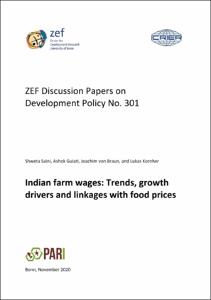Indian farm wages: Trends, growth drivers and linkages with food prices

Indian farm wages: Trends, growth drivers and linkages with food prices

| dc.contributor.author | Saini, Shweta | |
| dc.contributor.author | Gulati, Ashok | |
| dc.contributor.author | von Braun, Joachim | |
| dc.contributor.author | Kornher, Lukas | |
| dc.date.accessioned | 2022-05-13T13:17:17Z | |
| dc.date.available | 2022-05-13T13:17:17Z | |
| dc.date.issued | 11.2020 | |
| dc.identifier.uri | https://hdl.handle.net/20.500.11811/9798 | |
| dc.description.abstract | This study looks at trends in Indian farm wages, analyses their linkage with food prices, and identifies factors which drove their growth in real terms. We employ quantitative and qualitative analysis techniques for this purpose. A vector-error correction model (VECM) is used to determine the linkage between farm wage inflation and food inflation, and a pooled mean group (PMG) estimation method, used for dynamic heterogeneous panels, is used to identify the drivers of growth in real farm wages.
In last 20 years (1998-99 to 2017-18), wages of India’s farm labourers increased at an average annual rate of 9.3 per cent in nominal and 3.2 per cent in real terms. For an average agricultural labourer, the daily wage rates increased from less than INR 45 in 1998-99 to about INR 229 in 2017-18. In real terms (2004-05 prices), this increase was from INR 50 to about INR 90 per day. The empirical analysis of the monthly wage time series identified a structural break in January 2007. Specifically, the curve is near-flat before this break-point subsequent which it rises sharply. On the relation between food inflation and wage growth, evidence was found of a food-wage spiral where changes in food prices and farm wages were estimated to impact each other. However, the impact of food inflation emerged to be stronger on wages than vice-versa and this impact was observed to strengthen post 2007-08. The panel study (1987-88 to 2015-16) on the drivers of real wage growth was conducted around the January 2007 structural break. Before this break, growth in real wages was estimated to be mostly driven by growth in the agriculture sector. Any influence of non-agricultural sectors (manufacturing and construction) did not emerge significant during this period. However, post the break, the growth witnessed in both- non-agricultural (manufacturing and construction sectors) and agricultural sectors explained the sharp increases in real farm wages. The large public rural employment program, MGNREGA (introduced in 2005) was identified as a third potential force of influence on rural wages; however, among other significant factors, its contribution to farm wage growth was estimated to be low and with a lag. Policy implications based on these findings are that for faster growth in real farm wages, focus needs to be on augmenting labour productivity in agriculture. In order to pursue that, one needs to lead reforms in agriculture that can accelerate agri-GDP growth and ensure that the rest of the economy, especially the manufacturing and construction sector, grow much faster pulling labour out from the agricultural sector to higher productivity jobs in manufacturing, construction, and possibly also services. | en |
| dc.format.extent | 51 | |
| dc.language.iso | eng | |
| dc.relation.ispartofseries | ZEF Discussion Papers on Development Policy ; 301 | |
| dc.rights | In Copyright | |
| dc.rights.uri | http://rightsstatements.org/vocab/InC/1.0/ | |
| dc.subject | India | |
| dc.subject | Policy | |
| dc.subject | Food and nutrition security | |
| dc.subject | Employment | |
| dc.subject | Agricultural production | |
| dc.subject.ddc | 320 Politik | |
| dc.subject.ddc | 330 Wirtschaft | |
| dc.subject.ddc | 630 Landwirtschaft, Veterinärmedizin | |
| dc.title | Indian farm wages: Trends, growth drivers and linkages with food prices | |
| dc.type | Arbeitspapier | |
| dc.publisher.name | Center for Development Research (ZEF) | |
| dc.publisher.location | Bonn | |
| dc.rights.accessRights | openAccess | |
| dc.relation.eissn | 1436-9931 | |
| dc.relation.doi | https://doi.org/10.2139/ssrn.3724928 | |
| dc.relation.url | https://www.zef.de/fileadmin/webfiles/downloads/zef_dp/ZEF_DP_301.pdf | |
| ulbbn.pubtype | Zweitveröffentlichung |




